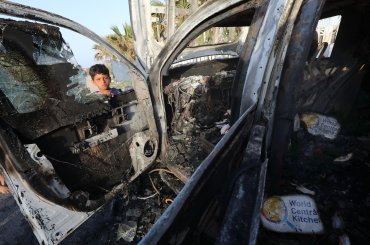The Palestinian resistance movement looked very different 45 years ago in the early 1970s. With a significant presence in Lebanon, the movement and international activists that supported it found themselves in a unique environment. Progressive organizations from across the world, including American Indian Movement, were hosted by various Palestinian groups and visited offices, charities, the PLO Research Centre and of course the Palestinian refugee camps.
As one of those visiting activists, I was amazed by the depth and breadth of what was then being achieved, especially in intellectual research and cultural development. The refugee camps at that period represented Palestinian pride and struggle rather than charity and victimhood.
However, the case of the Tel al-Zaatar camp and the PLO Research Centre, both now destroyed and “invisible,” highlight the attempts to obscure this period of Palestinian resistance.
Returning to Lebanon last month was both inspiring and troubling. Many parts of Beirut and even the south of Lebanon are in a frenzy of over-development against a background of failing infrastructure and a dysfunctional central government. In many areas, there is nothing left to recognize from 45 years ago, especially given the destruction that occurred during the years of the devastating civil war and the subsequent 1982 Israeli military invasion. And against this backdrop, Palestinians in Lebanon exist in a precarious balance between resistance and near-abandonment by official forces, be they Lebanese, Palestinian or international.
Physically speaking, the Palestinian refugee camps that still remain (some were destroyed) were one of the few places that seemed familiar, in part due to the official and discriminatory building restrictions. But the narrow damp alleyways, the spiderweb of overhead electrical wires, the beautifully painted murals at the entrance of many camps…all of these evoked memories.
However, the camps located in Beirut despite the familiar surroundings, demographically no longer contain a majority of Palestinian residents due to recent influxes of refugees from Syria and foreign workers. Lebanon has the highest per capita refugee population in the world today, something Western countries would never accommodate nor tolerate and something that has created new social problems within the camps themselves.
One of our objectives was to try to find the remains of Tel al-Zaatar refugee camp, which was destroyed early on in the civil war in 1976. It was known as one of the most militant and organized camps and had the misfortune of being in the wrong “geographic area” of Beirut; I had visited it often and even lived there for a short time. Our host from Burj al Barajneh helped to drive us around, stopping passersby and asking about the camp, most of whom were totally unaware of even its previous existence. Although we knew the general location, we were attempting to demarcate the exact perimeter of where the camp once stood. Now, there is nothing but an empty, deserted and garbage-filled area that seems to have not been touched since it was razed to the ground and all signs of life removed. Its desolate, and there is no plaque or memorial, no evidence whatsoever that a vibrant Palestinian camp of tens of thousands of people once lived here, and that at least 2000 refugees died there during the brutal three-month siege of the camp. After an exhausting several hours, we felt we had achieved the best “mapping” we could of where the camp had been. One more segment of Palestinian history that the world seemed intent on trying to erase!

The next stop was Shatila camp, and the Palestinian martyr’s cemetery. There, by chance, we discovered what is probably the only public memorial to Tel al-Zaatar camp in Beirut, a large headstone dedicated in 1977 by the late Yasser Arafat. The cemetery also contains the graves of Palestinian leaders and intellectuals, many assassinated by Israeli special forces in extra-judicial operations. Looking at the row upon row of graves and headstones, large and small, one had to question what value today’s Palestinian leadership places on these sacrifices.
The PLO Research Centre, once a renowned hub of Palestinian analysis and extensive archiving of all things written on Palestine, has suffered the same fate as Tel al-Zaatar. Its resources and archives were looted by invading Israeli forces in 1982 and partially later recovered. However, in 1983, as the last Palestinian institution allowed to remain in Beirut after the civil war, it was hit by a car bomb that killed 20 people and injured many more. In the ensuing years, the remaining Centre’s archives were allowed to wither away, some reports say in a military desert camp in Algeria.
Why are such vital segments of Palestinian history now so obscured and difficult to trace and honor? The Israeli-U.S. agenda in suppressing Palestinian history is well-documented. And there have always been reactionary forces in Lebanon that are virulently anti-Palestinian and more than willing to help implement that agenda. However, the role of the Palestinian Authority in blotting out the record and narratives of this period of Palestinian struggle, whether intentional or not, is also pivotal. The function of the Research Centre was replaced by something called the Palestinian National Archives, as soon as the PA took power in Ramallah. The focus of this new archives was supposedly “state-building” and the director’s statement on its opening claimed that “a process of institution building immediately began as a stepping-stone for building the free and independent state…The main incentive [for building the archive] was our firm belief in the necessity of preserving the memory of our people, and the memory of its nascent entity, the Palestinian National Authority.” Words that might have been believable to some 25 years ago but now stand as a cruel mockery and indictment of the Oslo Process and its impact on the Palestinian struggle for national and human rights.
The history of what the Palestinian movement had achieved in Beirut during the 1970s and the fruits of that Palestinian renaissance that embodied the best thinkers of the time, was (and is) a history that cannot be erased. Palestinian refugees in Lebanon are often the test case for schemes to eradicate the Palestinian right of return with various programs of “resettlement,” and the current “deal of the century” is no exception. However, all such previous attempts have failed, and Palestinians in Lebanon and globally must be supported in their demands that the right of return is sacred and universal and cannot be sacrificed on the altar of imperial deal-making. The history of the continuing Nakba is a history that the world must acknowledge and accept, or there will never be true peace with justice in the region.



Ms. Kawas
An excellent and informative article. Well done!! Much appreciated!!
Israel is rotting within, increasingly viewed with disgust and anger around the world and most importantly, along with Zionism, being abandoned and scorned by Jewish youth.
As recent in depth DNA analysis has determined, including their ancestors, the Palestinians have lived between the River and the Sea for at least 15,000 years. They will still be there when the anachronistic entity know as “Israel” is but a footnote in history.
To quote the prediction of Henry Morgenthau Sr., former U.S. Ambassador to Turkey, 1919: “Zionism is the most stupendous fallacy in Jewish history…. The very fervour of my feeling for the oppressed of every race and every land, especially for the Jews, those of my own blood and faith, to whom I am bound by every tender tie, impels me to fight with all the greater force against this scheme, which my intelligence tells me can only lead them deeper into the mire of the past, while it professes to be leading them to the heights. Zionism is… a retrogression into the blackest error, and not progress toward the light.” (Quoted by Frank Epp, Whose Land is Palestine? p. 261)
…. ….
“The history of what the Palestinian movement had achieved in Beirut during the 1970s and the fruits of that Palestinian renaissance that embodied the best thinkers of the time, was (and is) a history that cannot be erased. Palestinian refugees in Lebanon are often the test case for schemes to eradicate the Palestinian right of return with various programs of “resettlement,” and the current “deal of the century” is no exception. However, all such previous attempts have failed, and Palestinians in Lebanon and globally must be supported in their demands that the right of return is sacred and universal and cannot be sacrificed on the altar of imperial deal-making. The history of the continuing Nakba is a history that the world must acknowledge and accept, or there will never be true peace with justice in the region.”
Many thanks for a great article , Ms Kawas !
This last paragraph should be a lasting testimony and pledge that until Justice for the Palestinians in their own historical homeland is achieved ” from the river to the sea ” there will be no Peace !!